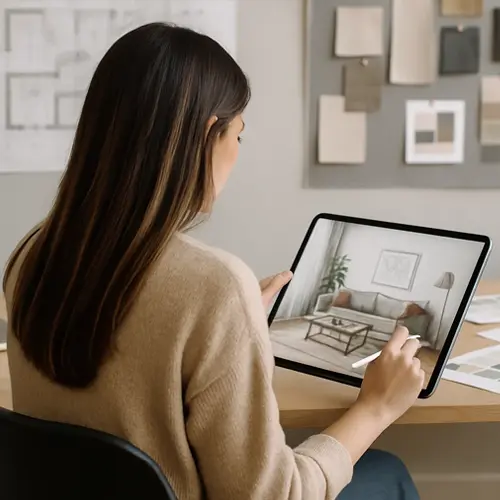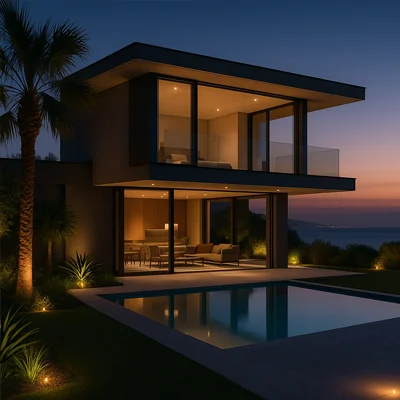- Aug 22, 2024
- jay
- 2
Becoming an interior decorator: a practical and comprehensive guide
Embarking on a career as an interior decorator is an exciting adventure that combines creativity, technique and an eye for detail. The idea of transforming ordinary spaces into aesthetically pleasing and functional places attracts many enthusiasts every year. But how do you actually become an interior designer? Stéphanie Mayer explains her career path to help you make your dream come true.
Assess your skills and motivations
A sense of aesthetics
To be a good interior decorator in Cannes, you need to have a strong taste for harmonious layouts and an ability to visualise abstract concepts. This aesthetic sense enables you to give the best advice to your customers, while respecting their tastes and budget.
Sensitivity to trends
Decorating trends are constantly evolving. A good decorator needs to keep abreast of new fashions and know how to incorporate these elements into his projects without losing sight of the functionality and usability of the space.
Technical skills
In addition to creativity, technical skills are necessary. These include drawing, mastery of specialist software such as AutoCAD or SketchUp, and a good understanding of materials and construction techniques.
Choosing the right course
BTS in space design
The BTS (Brevet de Technicien Supérieur) in space design is often the first step for those wishing to embark on this career. This two-year post-baccalauréat course (bac+2 level) provides a solid grounding in interior architecture, design and decoration.
DNA with a specialisation in space design
The Diplôme National d'Art (DNA) with an option in space design is another popular option. This three-year post-baccalauréat course focuses on the artistic and conceptual aspects of interior design and decoration.
Professional degree
To deepen your knowledge, a professional degree in space design or interior architecture is also available. This is a 3-year post-baccalaureate diploma that provides advanced expertise and specialisation in certain aspects of the interior design profession.
Further training
For people looking to retrain or improve their skills, continuing education is an excellent solution. Several schools and training centres offer courses tailored to working adults. These courses can be modular and adapted to your own pace, giving you valuable flexibility.
Gaining experience
Internships and apprenticeships
There's no substitute for hands-on experience. During your studies, look for work placements with interior designers in Saint-Tropez or with decorating companies. This practical experience will enhance your CV and enable you to apply your theoretical knowledge.
Personal projects
Undertaking personal projects is an excellent way of developing your portfolio. Whether it's for friends, family or even your own home, every project you complete is an opportunity to demonstrate your skills and creativity.
Entering competitions
Many design competitions exist to showcase young talent. Taking part in these competitions can give you valuable exposure and a chance to compare your creations with those of your peers.
Making yourself known
Portfolio presentation
A well-presented portfolio is essential. It should contain your best work and be clear and professional. Use high-quality photos accompanied by precise descriptions of the projects you have completed.
Network and take part in events
Attend trade fairs, exhibitions and conferences. These events are ideal opportunities to meet professionals, exchange ideas and expand your network.
Use social networks
In today's world, a strong online presence is essential. Create profiles on Instagram, Pinterest and LinkedIn to share your achievements and attract the attention of potential clients and employers.
Legislation and professional status
Setting up your own business
If you are planning to work as a self-employed person, setting up your own business may be an option. Choose between auto-entrepreneur or company status, depending on the scope of your projects and your ambitions.
Administrative declarations
Don't forget to find out about the administrative formalities required to operate your business legally. This includes registering with the relevant bodies and obtaining the necessary insurance.
Pricing and estimates
Learn how to draw up clear and precise estimates. Clear pricing from the outset avoids unpleasant surprises and ensures a relationship of trust with your customers.
Continuously enhancing your skills
Further training
The field of interior design is evolving rapidly. Regularly attending further training courses or workshops helps you keep up to date with new techniques and trends.
Keeping up with technological innovations
Digital tools are becoming essential. Mastering 3D design, virtual reality and augmented reality software can significantly increase the quality and efficiency of your projects.
Read and document
Don't hesitate to read specialist magazines, books on art and design, and decorating blogs to feed your inspiration and discover new stylistic approaches.
Developing your personal style
Finding your signature
Every interior designer has their own style, a ‘signature’ that sets them apart from the rest. To find yours, experiment with different trends and observe what inspires you most.
Analyse the styles of the masters
Study the works of the great names in interior design. Drawing inspiration from iconic figures such as Philippe Starck or Andrée Putman can guide your own creative process.
Experiment and innovate
Don't be afraid to think outside the box. Innovation often comes from daring and experimentation. Try new combinations of colours, textures and furniture to create unique spaces.
Understanding customer expectations
Effective communication
Clear and transparent communication with your customers is the key to success. Listen to their needs and desires, and don't be afraid to ask questions to understand their expectations.
User-centred design
Always put the user at the centre of your thinking. Every space must not only be beautiful, but also functional and comfortable for those who will use it on a daily basis.
Flexibility and adaptability
Sometimes it's necessary to revise your plans along the way. Show yourself to be flexible and capable of adjusting your proposals according to feedback and unforeseen constraints.
Mistakes to avoid
Ignoring technical rules
Creativity is important, but you should never neglect the technical and regulatory aspects. Make sure that all your proposals comply with current safety and construction standards.
Neglect the budget
Respecting the budget allocated by your customers is essential. Unexpected overruns can damage your reputation and lead to disputes.
Impose your personal taste
While adding your personal touch, remember that you are working to make your customers' dreams come true. Their satisfaction comes first.
Getting into the interior design business is an ambitious project, but one that can be achieved with the right training, practical experience and a continuous learning attitude.
Latest News
-
Luxury interior design fo...
By Stéphanie Mayer
-
The secrets of interior d...
By Stéphanie Mayer
-
Interior design trends in...
By Stéphanie Mayer





